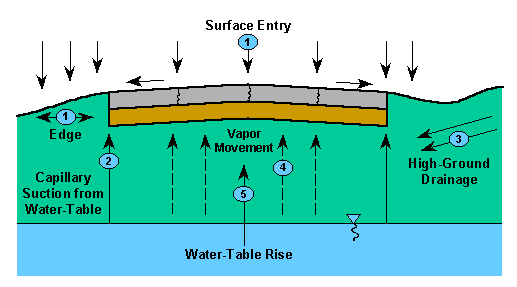 Please note – Intersections come in all lengths, widths, and loading conditions. Conventional asphalt mixes and pavement design are more than adequate for most traffic conditions. However, there are circumstances and high-stress loading conditions that require special consideration and mixes designed specifically for the application. These high-stress situations are the focus of this chapter. Traffic loading and the materials required to address these conditions are very similar between heavy loaded intersections and truck climbing lanes. Due to the wide range of conditions and loading only the basics of design principals and a few special considerations are covered here. Both high-stress intersections and truck climbing lanes incorporate heavy pavement loading; therefore, it is critical that they be properly designed. Asphalt concrete is well suited for this type of application because it permits the versatility of varied pavement designs while maintaining maximum pavement strength.
Please note – Intersections come in all lengths, widths, and loading conditions. Conventional asphalt mixes and pavement design are more than adequate for most traffic conditions. However, there are circumstances and high-stress loading conditions that require special consideration and mixes designed specifically for the application. These high-stress situations are the focus of this chapter. Traffic loading and the materials required to address these conditions are very similar between heavy loaded intersections and truck climbing lanes. Due to the wide range of conditions and loading only the basics of design principals and a few special considerations are covered here. Both high-stress intersections and truck climbing lanes incorporate heavy pavement loading; therefore, it is critical that they be properly designed. Asphalt concrete is well suited for this type of application because it permits the versatility of varied pavement designs while maintaining maximum pavement strength.
The key to achieving this desired performance at high-stress installations is recognizing that these pavements may need to be treated differently than regular, posted-speed pavements.
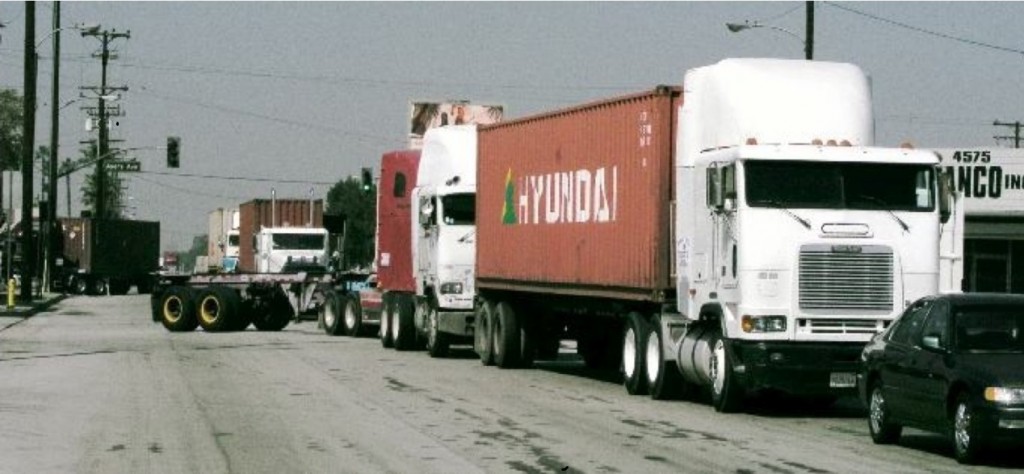
Design Considerations
Pavement designers and contractors have learned that some intersections need special attention. The braking, stopping, acceleration, and turning of slow-moving, heavy vehicles expose intersections to some of the highest stress levels found on pavements. Because truck climbing lanes with their slow-moving, heavy vehicles truck climbing lanes have many similarities. Giving special attention to pavement design and material choices in these areas can ensure that high-stress areas deliver the same outstanding performance as other asphalt pavements. This chapter recommends pavement engineers adopted a four-point strategy to ensure good performance for intersections and truck climbing lanes. This strategy can also be used to evaluate existing pavements and applied to other high-stress applications.
Four Step High-Stress Strategy:
- Evaluate the situation (subgrade strength, traffic loading, traffic speed, etc.).
- Ensure that the pavement design is structural adequate for the loading and speed.
- Select materials and mixes specifically designed for these conditions and confirm design.
- Ensure proper construction techniques.
Evaluate the Situation
There are three types of rutting:
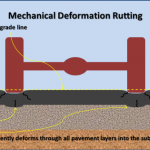 1. Mechanical Deformation – The result of insufficient pavement structural capacity (too thin). Rutting occurs at the surface and is carried through to the underlying subbase and/or subgrade. Usually accompanied by alligator cracking.
1. Mechanical Deformation – The result of insufficient pavement structural capacity (too thin). Rutting occurs at the surface and is carried through to the underlying subbase and/or subgrade. Usually accompanied by alligator cracking.
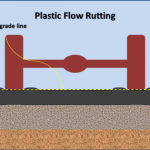 2. Plastic Flow – This type of rutting typically occurs during the summer months when pavement temperatures are high. A properly designed mixture with a stiffer asphalt binder and strong aggregate structure will resist shear movement in the asphalt layer
2. Plastic Flow – This type of rutting typically occurs during the summer months when pavement temperatures are high. A properly designed mixture with a stiffer asphalt binder and strong aggregate structure will resist shear movement in the asphalt layer
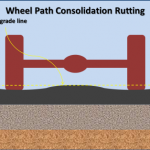 3. Wheel Path Consolidation – This type of rutting in the wheel paths occurs when pavement layers are not adequately compacted at time of construction. Once open to traffic the layer(s) consolidate in the wheel paths over time depending on traffic volume and loading. A number of factors can contribute to lack of compaction.
3. Wheel Path Consolidation – This type of rutting in the wheel paths occurs when pavement layers are not adequately compacted at time of construction. Once open to traffic the layer(s) consolidate in the wheel paths over time depending on traffic volume and loading. A number of factors can contribute to lack of compaction.
Ensuring Structural Adequacy
 Intersection and truck climbing lane pavements must have adequate thickness to provide the structural capacity to meet traffic needs. For new pavements, thickness design must account for normal factors such as subgrade strength, base thickness, and traffic. These pavements should be as thick as or thicker than the adjacent pavement. Too often pavements are designed considering the trucks moving at the posted speed limit, but it is the braking, slow movement turning movements and stationary/sitting loading that result in failures if not properly addressed in the pavement design.
Intersection and truck climbing lane pavements must have adequate thickness to provide the structural capacity to meet traffic needs. For new pavements, thickness design must account for normal factors such as subgrade strength, base thickness, and traffic. These pavements should be as thick as or thicker than the adjacent pavement. Too often pavements are designed considering the trucks moving at the posted speed limit, but it is the braking, slow movement turning movements and stationary/sitting loading that result in failures if not properly addressed in the pavement design.
For existing pavements, it is critical that the structural adequacy of the in-place material be evaluated. Any failed or weak layers must be removed. Simply paving over existing failed material will likely result in recurring failure.
Selecting High-Performance Asphalt Mixes and Materials
High-Performance Asphalt Binders – The Superpave mix design pro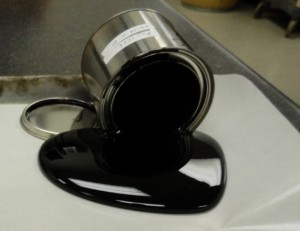 cess and Performance Grade (PG) binder system, provides engineers the necessary tools for improving the performance of asphalt intersections, truck climbing lanes, and other high-stress locations. One of the provisions for selecting the appropriate PG binder to bind the aggregate particles together in the finished pavement recognizes the need for a stiffer binder for slowed or stopped traffic associated with intersections. This provision, commonly called “grade bumping,” rounds up one or two higher grades for heavy, slow-moving traffic and standing or stopping traffic. The base binder grade in Virginia is a PG 64-22, therefore, we recommend a PG 76-22 be used for intersections and truck climbing lanes.
cess and Performance Grade (PG) binder system, provides engineers the necessary tools for improving the performance of asphalt intersections, truck climbing lanes, and other high-stress locations. One of the provisions for selecting the appropriate PG binder to bind the aggregate particles together in the finished pavement recognizes the need for a stiffer binder for slowed or stopped traffic associated with intersections. This provision, commonly called “grade bumping,” rounds up one or two higher grades for heavy, slow-moving traffic and standing or stopping traffic. The base binder grade in Virginia is a PG 64-22, therefore, we recommend a PG 76-22 be used for intersections and truck climbing lanes.
While the asphalt binds the pavement together, waterproofs, and gives additional stiffness, it is the aggregate structure that actually carries the load. This makes the aggregate selection and blending a critical step. Superpave aggregate requirements (coarse aggregate angularity, fine aggregate angularity, flat and elongated particles, and clay content) are used to characterize the aggregate being considered. As the expected traffic loading on the pavement increases, the aggregate and aggregate blend must meet higher standards. A successful blend of the aggregate must have high internal friction to develop the degree of interlock needed to resist shearing or rutting. Tough, durable aggregates are necessary. Rounded aggregate must be avoided in both the coarse and fine fractions.
Use of proper construction techniques is, of course, important for all pavements, and it is critical for high-performance intersections. Three aspects are worth special mention here: proper compaction, avoidance of segregation, and excellent joint construction.
Proper density is vital for long-term durability. The mixture must be properly compacted to resist additional compaction under heavy traffic. Proper compaction also reduces air and water intrusion that could cause accelerated aging and reduce the long-term durability of a pavement.
Segregation occurs when different-size aggregate particles separate in the mixture during handling and placement, creating a weaker, more open-textured pavement that is less durable. Best management practices to
Proper Construction Techniques
The secret to intersection construction is no secret-practice proper construction techniques and pay attention to details. Implementation of an intersection strategy will result in a dramatic increase in the performance life of the pavement – reducing life-cycle costs. Evaluating the performance history of intersections and other similar high-stress areas should play a key role in deciding whether changes should be made to the normal procedures. Although the initial unit cost of building these improved asphalt intersections may be higher than the cost of regular asphalt pavements, they will still only cost a fraction of that of Portland cement concrete (pcc). These improved asphalt intersections can be constructed much quicker – avoiding lengthy lane closures and rerouting of traffic, which is necessary with pcc construction and curing. The final product will be a long-lasting, cost-effective, smooth asphalt intersection.
Drainage
Adequate pavement drainage is of great importance to all pavement designs. If the subgrade under the pavement becomes saturated, it will lose strength and stability and make the overlying pavement structure susceptible to break up under imposed loads. Both surface and subsurface drainage must be considered. All drainage must be carefully designed and should be installed in the construction process as early as is practicable. The pavement should also be constructed in a manner that will not permit water to collect at the pavement edge and provisions should be made to intercept all groundwater from springs, seepage planes, and streams. When used, curb and gutter sections should be set to true line and grade. Marshy areas will require special consideration and should be addressed during the planning stage.
Drainage impacts pavement performance when the subgrade materials and pavement layer materials are saturated and lose strength. Water that falls on the pavement surface must be drained to curb and gutter systems or ditches. Water that penetrates the pavement from the surface; infiltrates from the sides of the road, or rises from under the pavement should not be allowed to compromise the overall strength.
Every effort should be made to prevent surface water from crossing streets at intersections. Not only is there a danger of hazardous stopping of traffic, the street depression necessary to permit drainage to cross the intersection restricts vehicular movement due to the low speed required to negotiate it.
To account for surface water drainage, it is important that the road is constructed with a crown or cross slope. Typically, a crown is placed in the center of the road and the pavement is sloped 2% in each direction. Occasionally, the pavement will be super-elevated where one side of the road is higher than the other. In either case, the pavement must be sloped to keep water from ponding on the surface.
For subsurface water, the approach to address varies based on the project. In some situations, underdrains are placed to intercept water that may flow under a pavement. This water is then allowed to flow out into a ditch or is put in a stormwater system. In many cases where the subgrade becomes weaker due to water, the subgrade is stabilized with a binding agent, removed and replaced with a stronger material, covered with a stabilization fabric prior to placing the next pavement layer or the next pavement layers are made thicker.
Soil Support
The ability of the native subgrade soil to support loads transmitted through the pavement is one of the most important factors in determining pavement thickness. Prior to construction or developing the project plans, the subgrade should be sampled and tested for strength. The primary strength parameter for subgrade soil is the California Bearing Ratio or CBR and quantifies how well the soil can withstand traffic loads. The CBR test provides a simple and dependable index of a soil’s load-bearing capacity, the lower the value, the less strength the soil has. It is widely used by many highway departments as well as other governmental agencies on both the state and federal levels.
Overall, all projects should be sampled and tested by a qualified engineering firm. The number of samples will depend on the length of the road and the changes in soil type. VDOT testing manuals can be consulted for recommended testing rates.
However, the designer should be aware of the limitations of using averaged CBR values in determining soil support data. Up to one-third of the soil samples used to compute an average CBR will be below that value.
Example:
Nine CBR samples are taken on a proposed subdivision street in Richmond and their values are as follows:
The average CBR value for these samples is 10. However, samples #3, 7 and 8 were well below 10. If the pavement is designed based on an average CBR value of 10, pavement failure in the areas of test samples 3, 7 and 8 can be expected.
This Manual recommends a Design CBR value of two-thirds (2/3) the actual average CBR value be used in selecting pavement thickness (the Vaswani design method used by The Virginia Department of Transportation also uses a design value of two thirds (2/3) the average CBR value). This will help assure the adequacy of the pavement design.
In general, a design CBR value of 3 or less indicates a poor soil. Soils with this value should be removed to a depth of 12 inches to 18 inches and replaced with a stronger material, or stabilized with additives such as lime or cement to a depth between 6 inches and 12 inches.
ASTM Standard Test Method D 1883
Subgrade Preparation
Because the subgrade must serve both as a working platform to support construction equipment and as the foundation for the pavement structure, it is most important to see that it is properly compacted and graded. Laboratory tests to evaluate the load supporting characteristics of subgrade soil are required. Test data for the area may be available from the Virginia Department of Transportation’s local office.
All underground utilities should be protected or relocated prior to grading. All topsoil should be removed and low-quality soil must be improved by adding asphalt or other suitable admixtures such as lime or granular materials.
The areas to be paved should have all rock, debris, and vegetation matter removed. Grading and compaction of the area should be completed in such a manner as to prevent yielding areas or pumping of the soil. The subgrade should be compacted to a uniform minimum density of 95% of the maximum theoretical density.
Should a weak spot be discovered, the material should be removed and replaced with either six inches (6″) compacted crushed stone; or three inches (3″) compacted asphalt concrete. In case of extremely poor subgrade, it may be necessary to remove the upper portion of the subgrade and replace it with the selected material. When finished, the graded subgrade should not deviate from the required grade and cross section by more than one-half inch (1/2”) in ten feet (10′).
Base Construction (Asphalt)
Prior to placement of the asphalt concrete base course, the subgrade should be graded to the established requirements, adequately compacted, and all deficiencies corrected. The asphalt concrete base course should be placed directly on the prepared subgrade in one or more lifts, spread, and compacted to the pavement thickness indicated on the plans or established by the owner.
Compaction of asphalt mixtures is one of the most important construction operations contributing to the proper performance of the completed pavement, regardless of the thickness of the course being placed. This is why it is so important to have a properly prepared subgrade against which to compact the overlying pavement. The asphalt concrete should meet the Virginia Department of Transportation specifications for the mix type specified.
Base Construction (Aggregate)
The subgrade must be graded to the required contours and grade in a manner that will ensure a hard, uniform, well-compacted surface. All subgrade deficiency corrections and drainage provisions should be made prior to constructing the aggregate base.
The crushed aggregate base course should consist of one or more layers placed directly on the prepared subgrade, spread, and compacted to the uniform thickness and density as required on the plans or established by the owner. The absolute minimum crushed aggregate thickness is six inches (6″). All crushed aggregate material should be of Virginia Department of Transportation approved type and suitable for this type of application.
Tack Coat
Prior to placement of successive pavement layers, the previous course should be cleaned and, if needed, a tack coat of diluted emulsified asphalt applied. If the previous course is freshly placed and thoroughly clean, the tack coat may be eliminated.
Asphalt Surface Course
Material for the surface course should be asphalt concrete placed in one or more lifts to the true line and grade as shown on the plans or set by the owner. The asphalt concrete should conform to Virginia Department of Transportation specifications for asphalt concrete. The Asphalt surface should not vary from established grade by more than one-quarter inch (1/4”) in ten feet (10′) when measured in any direction. Any irregularities in the surface of the pavement course should be corrected directly behind the paver. Rolling and compaction should start as soon as the asphalt concrete can be compacted without displacement and continued until thoroughly compacted and all roller marks disappear.
Curb and Gutter
Designed to provide roadway drainage, curb and gutters also delineate the roadway edge. Gutter widths vary from one (1’) to two (2’) feet, with a one and-one-half (1 ½’) foot width being most common. Vertical curbs range between five (5”) and eight (8”) inches in height, with a six (6”) inch high curb preferred.
One of the most common errors in pavement design is not specifying the appropriate grades to ensure that water does not collect on the pavement. On many collector streets, the elevation of the pavement is below that of the curb and gutter. As water is the biggest enemy of any pavement, these “dry curbs” will result in poor pavement performance and shorter pavement life.
Pavement Structure
The pavement structure and materials used will change as a function of subgrade strength and construction approach. Some projects will use full-depth asphalt (i.e., asphalt placed directly on compacted subgrade) and some will use an aggregate base placed on compacted subgrade. The aggregate base will be covered with one or more layers of asphalt. The table below is the minimum pavement designs. Each layer is the compacted thickness. At no time should less than 6 inches of an aggregate subbase layer be used.
Pavement Thickness
The values for pavement thickness given in this Chapter are minimum compacted thicknesses. Any reduction of the pavement thickness values shown for base or surface may cause severe pavement failure and/or a shorter pavement life.
Table 1 – Full-Depth Asphalt Pavement
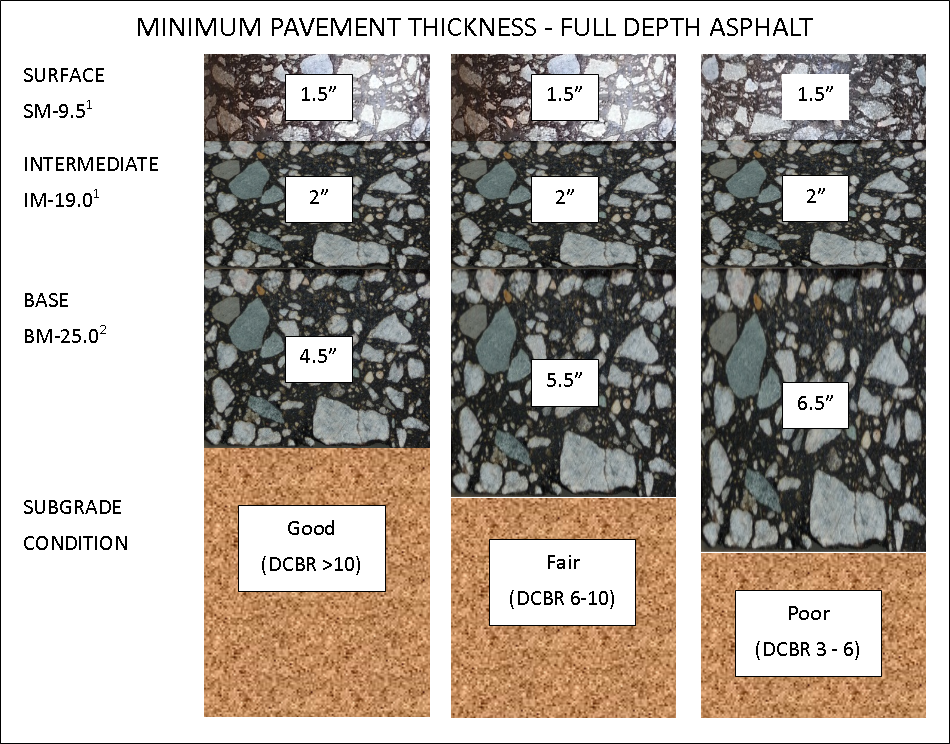
Table 2 –Asphalt with Aggregate Sub-Base Pavement
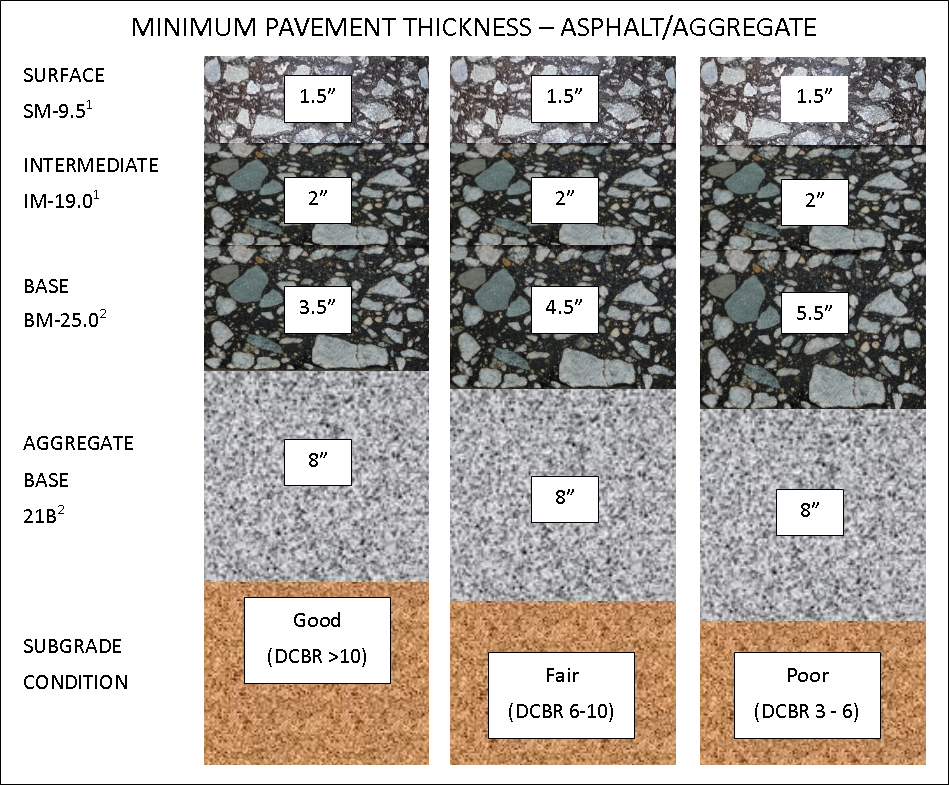
Notes:
- Design CBR is defined as 2/3 of the soaked CBR value.
- VDOT Specifications for SM-9.5 and BM-25.0 can be found in Section 211 of the VDOT, Road and Bridges Specification Book.
- VDOT Specifications for 21B can be found in Section 208 of the VDOT, Road and Bridges Specification Book.
- (1) Due to the heavy loads applied to the surface, a stronger asphalt binder is recommended. A PG 64E-22 meeting the VDOT specifications outlined in Section 211 of the 2016 VDOT, Road and Bridge Specifications Book, is typically used in these applications. Given the nature of PG 64E-22, little to no handwork by the paving crew should be performed. This material works best for open pulls by the paver. If handwork is needed, then PG 64H-22 should be used. Consult your local paving contractor for assistance in determining the amount of handwork.
- (2) Due to the heavy loads applied to the pavement, a stronger asphalt binder is recommended. A PG 64H-22 or equivalent that meets the VDOT specifications outlined in Section 211 of the 2016 VDOT, Road and Bridge Specifications Book, is typically used in these applications.
Future Maintenance Considerations
In time, pavement failures may occur due to settlement or weakening of the soil or aggregate base layers. These will result in localized failures or potholes. To repair these failures, the area impacted should be cut out and the pavement material removed to the subgrade. The subgrade material may need to be removed and replaced or simply recompacted. Finally, the removed pavement material should be replaced with new asphalt concrete or a permanent asphalt patching material.
As asphalt ages, shrinkage cracks will develop. Individual transverse and longitudinal cracks should be sealed with an asphalt-based material to reduce the amount of water infiltrating the underlying pavement layers. If the cracking is extensive, then the pavement can be overlaid with a new AC surface or milled and replaced with a new AC surface. Overlaying can be performed on areas without curb and gutter. For areas with curb and gutter, milling may be needed to maintain surface drainage. While edge milling can be performed, typically 4 to 6 feet in width at the edge of the pavement, full pavement milling is recommended in order to keep proper cross-slope.
References
- 2016 VDOT Road and Bridges Specifications
- VDOT Special Provisions to the 2016 Road and Bridges Specifications
- VAA Pavement Design Manual
